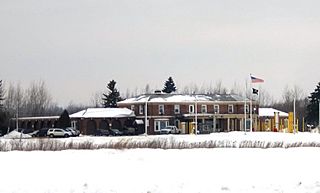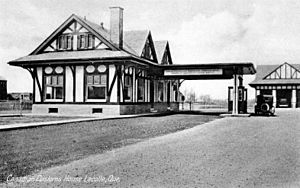Rouses Point–Lacolle 223 Border Crossing facts for kids
Quick facts for kids Rouses Point - Lacolle 223 Border Crossing |
|
|---|---|

US Border Inspection Station at Rouses Point, NY
|
|
| Location | |
| Country | United States; Canada |
| Location |
|
| Coordinates | 45°00′37″N 73°22′15″W / 45.010235°N 73.370819°W |
| Details | |
| Opened | 1913 |
| US Phone | (518) 297-2441 |
| Canadian Phone | (450) 246-3510 |
| Hours | Open 24 hours |
|
U.S. Inspection Station—Rouses Point (St. John's Highway), New York
|
|
| Lua error in Module:Location_map at line 420: attempt to index field 'wikibase' (a nil value). | |
| Location | NY 9B, Rouses Point, New York |
| Built | 1931 |
| Architect | Simon, Louis A.; Wetmore, James A. |
| Architectural style | Georgian Revival |
| MPS | U.S. Border Inspection Stations MPS |
| NRHP reference No. | 14000574 |
| Added to NRHP | September 10, 2014 |
The Rouses Point - Lacolle 223 Border Crossing connects the towns of Lacolle, Quebec in Canada and Rouses Point, New York in the United States. This important crossing is open all day, every day, all year round.
Because the town of Lacolle, Quebec has two border crossings, the CBSA calls this one 223. This name shows it's the crossing located on Quebec Route 223. The other crossing is the Overton Corners–Lacolle 221 Border Crossing, which is a little to the west. In the past, this crossing was known as Cantic, named after a local village that no longer exists.
Many years ago, during a time when certain goods were restricted in the United States, this border crossing became very busy. U.S. Route 11, which leads to this crossing, was one of the few paved roads available back then.
At first, the US Customs office was not right at the border. Travelers had to drive into the village of Rouses Point to report their goods for inspection. This made it difficult for officials to check everything properly. So, the United States Customs Service decided to build a special border station right at the border. Even though the rules about restricted goods changed by the time the building was finished, the station was still very useful.
In 2014, the US border inspection station was added to the National Register of Historic Places. This means it's recognized as an important historical site.
Contents
Canada's Lacolle 223 Border Station
Canada has had a border inspection station at this crossing for a long time, even before the US built its facility in 1936. In 1932, Canada built a beautiful border station in the Tudor-revival style. This building stood until it was replaced by a new brick building in 1971. The original garage from the 1932 station is still standing at the north end of the CBSA property today. A similar Tudor-revival style border station can still be seen at the Trout River Border Crossing.
United States' Rouses Point Border Station
The US Border Inspection Station at Rouses Point is located on a large 81-acre piece of land. It sits on the west side of St. John's Highway, which is New York Route 9B, right at the Canada–US border. The building faces east and is surrounded by open fields.
The main building has a central part with two stories and two single-story wings on its north and south sides. It also has two more single-story wings on the west side, making the building look like a "U" shape. A large canopy covers three lanes where cars coming from Canada are directed for inspection. There's an oval-shaped driveway and parking spots for visitors. The area around the building has spruce trees and hedges, which were part of a beautification program.
The main part of the building is made of red brick and has a roof covered in slate. It has decorative corners and a marble band between the floors. The building has many windows, and the main entrance has double doors.
The south wing of the building has four arched openings for vehicles. The north wing has windows and an entrance for people walking. Both wings have slate roofs. There's also a garage on the west side with eight arched openings, some of which still have their original wooden doors.
Inside the building, a main hallway leads to stairs. This hallway divides the first floor into offices. On one side are offices for Immigration, and on the other side are offices for Customs. These offices have long counters that separate the public area from the work area. Some parts of the interior, like the red tile floors and plaster walls, are still original.
Why This Station Is Important
The US Border Inspection Station in Rouses Point, New York is the easternmost border station in New York State. It is one of seven border stations built between 1931 and 1934 along the New York and Canada–US border. This building is designed in the Georgian Revival style. It was designed by the Office of the Supervising Architect and built in 1931.
These border stations were built for several important reasons in US history. One reason was to help control the movement of goods across the border. Another reason was the Public Buildings Act of 1926, which allowed the government to build more public buildings. This act became even more important during the Great Depression, as it helped create jobs for many people who were unemployed. Also, more and more people were buying cars, making it easier to travel across the border, which meant more inspections were needed.
The Rouses Point-St. Johns border station is considered one of the most detailed and well-preserved stations in New York. Even though some parts of the building have been changed over time, it still looks much like it did when it was first built.
History of the Station
During a time in the 1920s when certain goods were restricted across the US, there was a lot of activity along the Canada–US border. In New York, customs officers and border patrol agents worked to control this. Often, the US Custom Houses were a mile or more away from the actual border. Travelers were expected to stop in town to report their purchases.
The government saw a chance to improve this situation with the Public Buildings Act of 1926. This act allowed the government to speed up its building program and provided money for new construction.
Rouses Point was a very important town on the New York–Canada border during this time. The road from Rouses Point to Plattsburgh was so busy that it was even called the "Rum Trail." The old Custom House in the town center was far from the border, making it hard to manage all the traffic. Because Rouses Point was so important, it received two border inspection stations. One was built here, and another was built at Overtons Corner, where another paved road from Canada entered the US.
Even though the rules about restricted goods changed by the time the Rouses Point-St. Johns border inspection station was completed, the station was still very important. People continued to travel and move goods across the border, so the station remained busy.
The construction of these border stations also helped the local economy. Many local people who were unemployed found work building and then working at the stations as customs inspectors. The Rouses Point-St. Johns station was one of the last of the seven New York stations to be built, but it is still actively used today.



